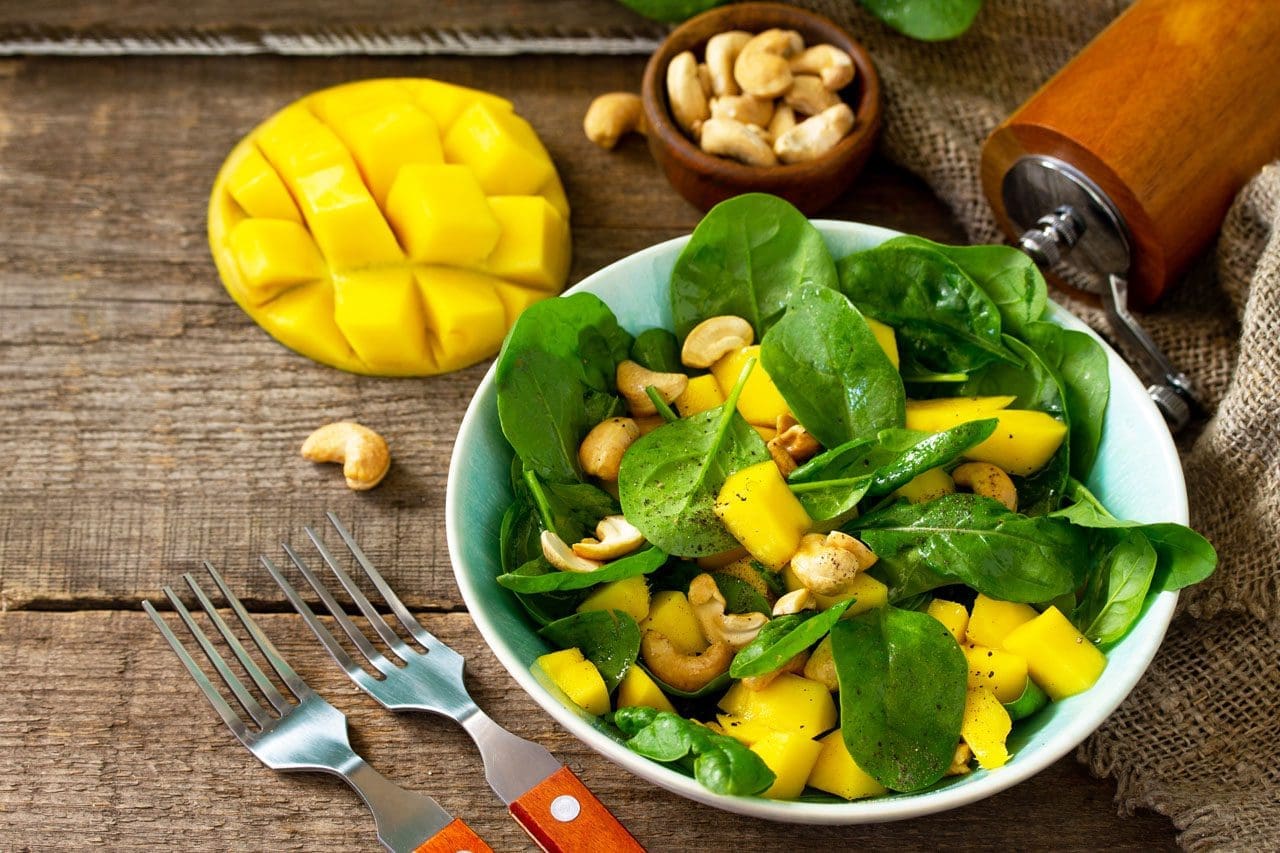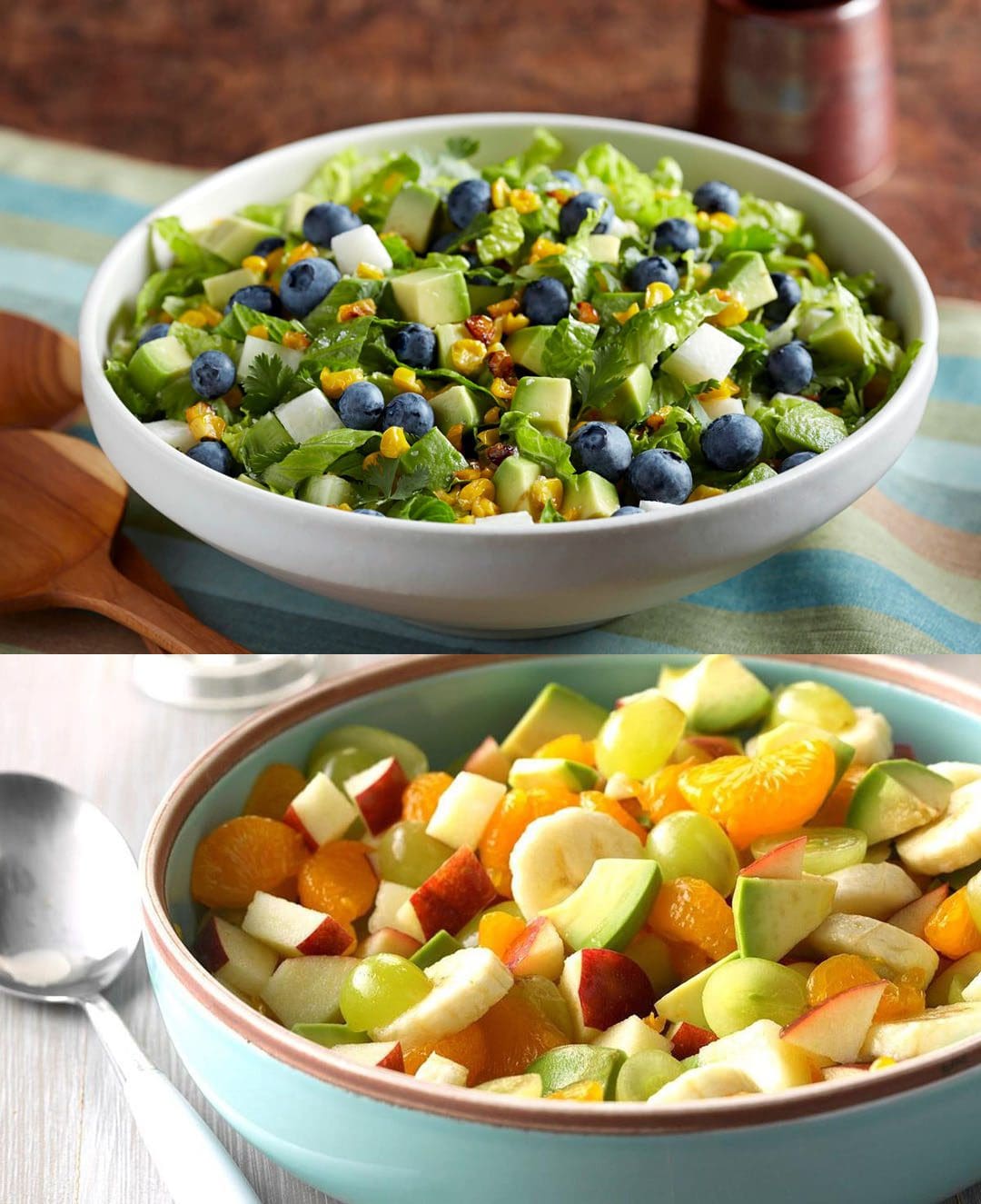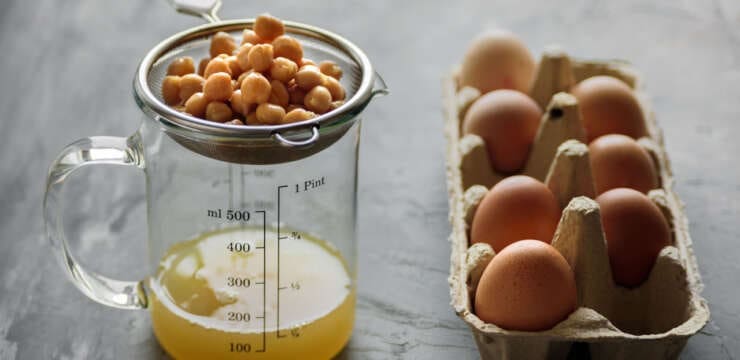
A satisfying salad is a great way to get more fruits and vegetables high in vitamins, minerals, and fiber. A salad using the right ingredients can be a filling meal. With the summer heat kicking in, making a quick, satisfying salad using your favorite ingredients can help cool off, rehydrate, and refuel the body.

Table of Contents
Making A Satisfying Salad
Leafy Greens
- Start with leafy greens.
- They’re low in calories and a healthy source of fiber.
- Different varieties include iceberg lettuce, leaf lettuce, spinach, escarole, romaine, kale, and butter lettuce.
- The darker greens offer more nutrients.
Vegetables
- Carrots, peppers, green beans, eggplant, Brussels sprouts, broccoli, cauliflower, cabbage, zucchini, tomatoes, cucumbers, onions, or scallions.
- Raw diced or cooked vegetables are a good addition.
- Leftover cooked vegetables will work.
- Brightly colored vegetables have flavonoids rich in antioxidants, fiber, vitamins, and minerals.
- Choose all the colors and add two or three half-cup servings.
Grains – Starch
- Add whole grains or starchy vegetables.
- A serving of cooked:
- Whole grains like brown rice, barley, or quinoa.
- Starchy vegetables like roasted sweet potatoes or cooked butternut squash.
- These provide fiber, complex carbohydrates, vitamins, and minerals.
Fruit
- Fruits or berries, blueberries, raspberries, blackberries, pomegranate seeds, apple slices, oranges, dates, and raisins can add vitamins, fiber, and antioxidants.
- One-half cup of apple slices has 30 calories.
- One-half cup of berries has about 40 calories.
Protein
- A hard-boiled egg is an excellent source of protein.
- A serving of lean beef, cooked shrimp, tuna, chicken breast, cheese strips, beans or legumes, hummus, tofu, or cottage cheese.
- Be mindful of portion size.
- A quarter cup of chopped chicken meat or one egg will add 75 calories.
- Half a can of tuna adds about 80 calories.
- Depending if it is low fat, two ounces of cubed or shredded mozzarella or cheddar cheese can add 200 calories.
Nuts or Seeds
- Almonds, cashews, walnuts, pecans, sunflower, pumpkin, or chia seeds are great for added crunch.
- All nuts add protein and heart-healthy polyunsaturated and monounsaturated fatty acids.
- One-eighth cup of nuts adds around 90 calories.
- Walnuts contain omega-3 fatty acids.
Salad Dressing
- Add salad dressing.
- One tablespoon of regular commercial salad dressing adds 50 to 80 calories.
- Low-fat and reduced-calorie dressings are available.
- Use freshly squeezed lemon or lime juice.
- Make a dressing with avocado, walnut, or extra virgin olive oil.
Low-Carbohydrate Taco Salad
This is an easy recipe. The meat can be prepared ahead or be leftovers from another meal.
Ingredients
- One pound lean ground beef – 85% to 89% lean.
- One tablespoon of chili powder.
- Salt and pepper, to taste.
- Green onions, chopped with white and green parts separated.
- One head of lettuce, chopped.
- One medium tomato, chopped.
- One avocado, diced.
- Optional – one 4-ounce can of sliced olives.
- 1 1/2 cups of grated fat-free cheddar, Monterey Jack cheese, or a combination.
- 1/2 cup fat-free Greek or plain yogurt.
- 1/2 cup salsa.
Preparation
- Cook beef in a skillet with chili powder, the white part of the onions, and salt and pepper.
- Once cooked, cover the pan.
- In a large salad bowl, mix the green onion, lettuce, tomato, avocado, and olives.
- Add the meat and cheese and gently toss together.
- Top with dollops of low-fat or reduced-calorie sour cream, yogurt, or salsa.
- Try other meats like ground turkey, chicken, or pork.
- For a vegetarian option, replace the ground meat with beans or textured vegetable protein.
- Adding beans will increase fiber, protein, and total carbohydrates.
Body Signals Decoded
References
Chambers L, McCrickerd K, Yeomans MR. Optimizing foods for satiety. Trends in Food Science & Technology. 2015;41(2):149-160. doi:10.1016/j.tifs.2014.10.007
Cox, B D et al. “Seasonal consumption of salad vegetables and fresh fruit in relation to the development of cardiovascular disease and cancer.” Public health nutrition vol. 3,1 (2000): 19-29. doi:10.1017/s1368980000000045
Dreher ML, Davenport AJ. Hass avocado composition and potential health effects. Crit Rev Food Sci Nutr. 2013;53(7):738-750. doi:10.1080/10408398.2011.556759
Roe, Liane S et al. “Salad and satiety. The effect of timing of salad consumption on meal energy intake.” Appetite vol. 58,1 (2012): 242-8. doi:10.1016/j.appet.2011.10.003
Sebastian, Rhonda S., et al. “Salad Consumption in the U.S. What We Eat in America, NHANES 2011-2014.” FSRG Dietary Data Briefs, United States Department of Agriculture (USDA), February 2018.
Yen, P K. “Nutrition: salad sense.” Geriatric nursing (New York, N.Y.) vol. 6,4 (1985): 227-8. doi:10.1016/s0197-4572(85)80093-8
Disclaimers
Professional Scope of Practice *
The information herein on "Making A Satisfying Salad: Health Coach Clinic" is not intended to replace a one-on-one relationship with a qualified health care professional or licensed physician and is not medical advice. We encourage you to make healthcare decisions based on your research and partnership with a qualified healthcare professional.
Blog Information & Scope Discussions
Welcome to El Paso's wellness blog, where Dr. Alex Jimenez, DC, FNP-C, a board-certified Family Practice Nurse Practitioner (FNP-C) and Chiropractor (DC), presents insights on how our team is dedicated to holistic healing and personalized care. Our practice aligns with evidence-based treatment protocols inspired by integrative medicine principles, similar to those found on dralexjimenez.com, focusing on restoring health naturally for patients of all ages.
Our areas of chiropractic practice include Wellness & Nutrition, Chronic Pain, Personal Injury, Auto Accident Care, Work Injuries, Back Injury, Low Back Pain, Neck Pain, Migraine Headaches, Sports Injuries, Severe Sciatica, Scoliosis, Complex Herniated Discs, Fibromyalgia, Chronic Pain, Complex Injuries, Stress Management, Functional Medicine Treatments, and in-scope care protocols.
Our information scope is limited to chiropractic, musculoskeletal, physical medicine, wellness, contributing etiological viscerosomatic disturbances within clinical presentations, associated somato-visceral reflex clinical dynamics, subluxation complexes, sensitive health issues, and functional medicine articles, topics, and discussions.
We provide and present clinical collaboration with specialists from various disciplines. Each specialist is governed by their professional scope of practice and their jurisdiction of licensure. We use functional health & wellness protocols to treat and support care for the injuries or disorders of the musculoskeletal system.
Our videos, posts, topics, subjects, and insights cover clinical matters, issues, and topics that relate to and directly or indirectly support our clinical scope of practice.*
Our office has reasonably attempted to provide supportive citations and has identified the relevant research studies or studies supporting our posts. We provide copies of supporting research studies available to regulatory boards and the public upon request.
We understand that we cover matters that require an additional explanation of how they may assist in a particular care plan or treatment protocol; therefore, to discuss the subject matter above further, please feel free to ask Dr. Alex Jimenez, DC, APRN, FNP-BC, or contact us at 915-850-0900.
We are here to help you and your family.
Blessings
Dr. Alex Jimenez DC, MSACP, APRN, FNP-BC*, CCST, IFMCP, CFMP, ATN
email: coach@elpasofunctionalmedicine.com
Licensed as a Doctor of Chiropractic (DC) in Texas & New Mexico*
Texas DC License # TX5807
New Mexico DC License # NM-DC2182
Licensed as a Registered Nurse (RN*) in Texas & Multistate
Texas RN License # 1191402
ANCC FNP-BC: Board Certified Nurse Practitioner*
Compact Status: Multi-State License: Authorized to Practice in 40 States*
Graduate with Honors: ICHS: MSN-FNP (Family Nurse Practitioner Program)
Degree Granted. Master's in Family Practice MSN Diploma (Cum Laude)
Dr. Alex Jimenez, DC, APRN, FNP-BC*, CFMP, IFMCP, ATN, CCST
My Digital Business Card






